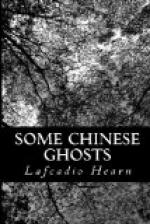“The Story of Ming-Y.”—The singular phantom-tale upon which my work is based forms the thirty-fourth story of the famous collection Kin-Kou-Ki-Koan, and was first translated under the title, “La Bacheliere du Pays de Chu,” by the learned Gustave Schlegel, as an introduction to his publication (accompanied by a French version) of the curious and obscene Mai-yu-lang-tou-tchen-hoa-kouei (Leyden, 1877), which itself forms the seventh recital of the same work. Schlegel, Julien, Gardner, Birch, D’Entrecolles, Remusat, Pavie, Olyphant, Grisebach, Hervey-Saint-Denys, and others, have given the Occidental world translations of eighteen stories from the Kin-Kou-Ki-Koan; namely, Nos. 2, 3, 5, 6, 7, 8, 10, 14, 19, 20, 26, 27, 29, 30, 31, 34, 35, and 39. The Chinese work itself dates back to the thirteenth century; but as it forms only a collection of the most popular tales of that epoch, many of the stories selected by the Chinese editor may have had a much more ancient origin. There are forty tales in the Kin-Kou-Ki-Koan.
“The Legend of Tchi-Niu.”—My authority for this tale is the following legend from the thirty-fourth chapter of the Kan-ing-p’ien, or “Book of Rewards and Punishments,”—a work attributed to Lao-tseu, which contains some four hundred anecdotes and traditions of the most curious kind:—
Tong-yong, who lived under the Han dynasty, was reduced to a state of extreme poverty. Having lost his father, he sold himself in order to obtain ... the wherewithal to bury him and to build him a tomb. The Master of Heaven took pity on him, and sent the Goddess Tchi-Niu to him to become his wife. She wove a piece of silk for him every day until she was able to buy his freedom, after which she gave him a son, and went back to heaven.—Julien’s French Translation, p. 119.
Lest the reader should suppose, however, that I have drawn wholly upon my own imagination for the details of the apparition, the cure, the marriage ceremony, etc., I refer him to No. XCVI. of Giles’s “Strange Stories from a Chinese Studio,” entitled, “A Supernatural Wife,” in which he will find that my narrative is at least conformable to Chinese ideas. (This story first appeared in “Harper’s Bazaar,” and is republished here by permission.)
“The Return of Yen-Tchin-King.”—There may be an involuntary anachronism in my version of this legend, which is very pithily narrated in the Kan-ing-p’ien. No emperor’s name is cited by the homilist; and the date of the revolt seems to have been left wholly to conjecture.—Baber, in his “Memoirs,” mentions one of his Mongol archers as able to bend a two-hundred-pound bow until the ears met.
“The Tradition of the Tea-Plant.”—My authority for this bit of folklore is the brief statement published by Bretschneider in the “Chinese Recorder” for 1871:—




